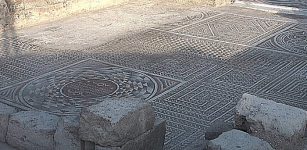Jolly Roger – Symbol Of Golden Age Piracy
A. Sutherland - AncientPages.com - One of the first associations that come to mind when we think about pirates is Jolly Roger, the black flag decorated with white skull and crossbones – the intent with a clear meaning – fear and intimidation.
Capture of the Pirate, Blackbeard, 1718, Jean Leon Gerome Ferris, painted in 1920 and the pirate’s flag.
Flags on ships played an important role; they allowed identifying whether a ship on the horizon was hostile or allied.
“Jolly Roger” was a common name for the famous symbol of European and American pirates and was always a hostile signal flag.
Pirate ships traditionally raised a solid black flag to identify themselves as pirates sending the message that if the ship put up no resistance, everyone on board would be given mercy.
If the ship chose to put up a fight, the black flag was replaced with a red flag, which sent the message that absolutely no mercy would be given. The color red in pirate flags symbolized bloodshed and the early pirates sailed under the Red Flags.
Both flags - a kind of psychological warfare - were intended to demonstrate the mighty power and fearlessness of the approaching pirate ship and to terrify.
Both colors had symbolic significance.
The origin of the name is not entirely clear. Some theories suggest that the flag took the name of "Old Roger" - the nickname, which was determined, by the devil, or "Roger" - the term for drifters, losers, and vagabonds.
Many historians believe that the term “Jolly Roger” dates further back in history, namely to the 13th century, when the image of a skull and crossbones was used by the Knights Templar and then adopted by the Knights of Malta who were known for their acts of piracy.
One popular theory (without any documented evidence) says the “Jolly Roger” name derives from the French "joli rouge" (pretty red) color of the flags used by pirates first.
The designs of the pirate flags varied much.
Red Sea raider Henry Every (or Avery) is reckoned by some to be the most successful pirate who ever lived.
While many pirates still continued to use plain black or red flags, some captains began to elaborate the flags’ design with symbols representing violence and death; some designs were associated with the captain’s reputation or presented messages and warnings addressed to his enemies.
For instance, John Rackham (widely known as “Calico Jack”, English pirate captain operating in the Bahamas and in Cuba during the early 18th century had a flag with a white skull over crossed swords on a black background, that became synonymous with the Golden Age pirate ships.
Henry Every’s flag was black and decorated with a white image of a bandana-wearing skull in profile over crossbones.
Blackbeard (Edward Teach or Thatch), a notorious English pirate who operated around the West Indies and the eastern coast of Britain's North American colonies, had a black flag with a white image of a horned skeleton holding an hourglass in one hand and spearing a red heart with the other.
This image was clearly meant to strike fear into the hearts of everyone he approached as the hourglass sent the message that time was running out and the speared heart suggested he would show no mercy.
Written by – A. Sutherland - AncientPages.com Senior Staff Writer
Copyright © AncientPages.com All rights reserved. This material may not be published, broadcast, rewritten or redistributed in whole or part without the express written permission of AncientPages.com
More From Ancient Pages
-
 5,000-Year-Old DNA Could Solve The Mystery Of Genetic Changes In Europe
Archaeology | Mar 8, 2022
5,000-Year-Old DNA Could Solve The Mystery Of Genetic Changes In Europe
Archaeology | Mar 8, 2022 -
 Large 4th Century Mosaic Floor Unearthed In İncesu, Kayseri Province, Turkey
Archaeology | Nov 28, 2023
Large 4th Century Mosaic Floor Unearthed In İncesu, Kayseri Province, Turkey
Archaeology | Nov 28, 2023 -
 Kallikantzaroi: Naughty Nocturnal Goblins Emerge From Underground Only During Twelve Days Of Christmas
Ancient Traditions And Customs | Jan 3, 2025
Kallikantzaroi: Naughty Nocturnal Goblins Emerge From Underground Only During Twelve Days Of Christmas
Ancient Traditions And Customs | Jan 3, 2025 -
 Famous Bayeux Tapestry May Solve The Planet Nine Mystery
Archaeoastronomy | May 5, 2018
Famous Bayeux Tapestry May Solve The Planet Nine Mystery
Archaeoastronomy | May 5, 2018 -
 Ancient DNA And Historical Context Were Used To Explain Kinship, Social Practices Of Avar Society
Archaeology | Apr 25, 2024
Ancient DNA And Historical Context Were Used To Explain Kinship, Social Practices Of Avar Society
Archaeology | Apr 25, 2024 -
 Potlatch: Ancient North American Indian Tradition Of Very Generous Gift Giving
Ancient Traditions And Customs | Sep 12, 2016
Potlatch: Ancient North American Indian Tradition Of Very Generous Gift Giving
Ancient Traditions And Customs | Sep 12, 2016 -
 Biblical Prophet Jeremiah Whose Prophecies Disappointed People
Biblical Mysteries | Jan 30, 2019
Biblical Prophet Jeremiah Whose Prophecies Disappointed People
Biblical Mysteries | Jan 30, 2019 -
 Broken Pebbles In Arene Candide Cave Shed New Light On Ancient Burial Practices
Archaeology | Mar 7, 2017
Broken Pebbles In Arene Candide Cave Shed New Light On Ancient Burial Practices
Archaeology | Mar 7, 2017 -
 Figurines Unearthed At 9,000-Year-Old Çatalhöyük Site Symbolize Elderly Women, Not Goddess Cybele
Archaeology | Mar 1, 2017
Figurines Unearthed At 9,000-Year-Old Çatalhöyük Site Symbolize Elderly Women, Not Goddess Cybele
Archaeology | Mar 1, 2017 -
 Giant Ancient Roman Underground Structure Discovered Near Naples, Italy – Aqua Augusta Investigated
Archaeology | Feb 6, 2023
Giant Ancient Roman Underground Structure Discovered Near Naples, Italy – Aqua Augusta Investigated
Archaeology | Feb 6, 2023 -
 Temple Of Lord Vishnu Dated To Hindu Shahi Dynasty Unearthed In Pakistan
Archaeology | Nov 22, 2020
Temple Of Lord Vishnu Dated To Hindu Shahi Dynasty Unearthed In Pakistan
Archaeology | Nov 22, 2020 -
 2,500-Year-Old ‘Dragon Bed’ Restored By Chinese Archaeologists
Archaeology | Jan 21, 2018
2,500-Year-Old ‘Dragon Bed’ Restored By Chinese Archaeologists
Archaeology | Jan 21, 2018 -
 Mythical Fiery Bird Phoenix In Mythologies Of Many Ancient Cultures
Featured Stories | Mar 23, 2017
Mythical Fiery Bird Phoenix In Mythologies Of Many Ancient Cultures
Featured Stories | Mar 23, 2017 -
 Ancient Chaco Canyon Was Much More Than A Ceremonial Site New Study Reveals
Archaeology | Oct 28, 2021
Ancient Chaco Canyon Was Much More Than A Ceremonial Site New Study Reveals
Archaeology | Oct 28, 2021 -
 Rare Gold Coins And Treasures Linked To Crusaders’ Conquest Of Caesarea – Discovered
Archaeology | Dec 4, 2018
Rare Gold Coins And Treasures Linked To Crusaders’ Conquest Of Caesarea – Discovered
Archaeology | Dec 4, 2018 -
 First AI-Based Method For Dating Archaeological Remains Developed By Researchers
Archaeology | Aug 23, 2022
First AI-Based Method For Dating Archaeological Remains Developed By Researchers
Archaeology | Aug 23, 2022 -
 10 Great Ancient Mysteries Of Africa
Civilizations | Mar 12, 2017
10 Great Ancient Mysteries Of Africa
Civilizations | Mar 12, 2017 -
 3,000-Year-Old Stone Scarab Seal Depicting A Pharaoh Discovered In Israel
Archaeology | Dec 2, 2022
3,000-Year-Old Stone Scarab Seal Depicting A Pharaoh Discovered In Israel
Archaeology | Dec 2, 2022 -
 New Theory On “Dry Moat” At The Pyramid Of Pharaoh Djoser
Archaeology | Jul 3, 2019
New Theory On “Dry Moat” At The Pyramid Of Pharaoh Djoser
Archaeology | Jul 3, 2019 -
 Climate In The Andes Has Driven 7,000 Years Of Dietary Changes – New Study Reveals
Archaeology | Feb 9, 2022
Climate In The Andes Has Driven 7,000 Years Of Dietary Changes – New Study Reveals
Archaeology | Feb 9, 2022



